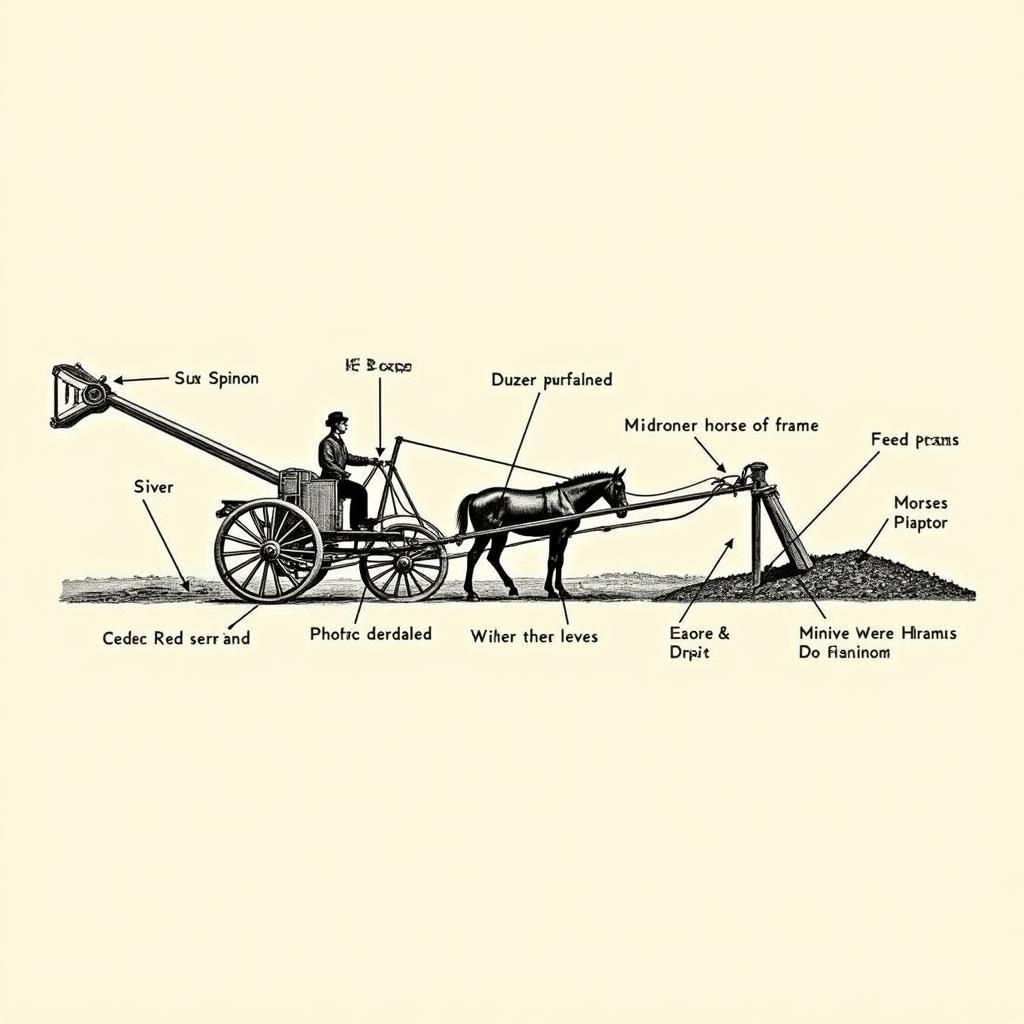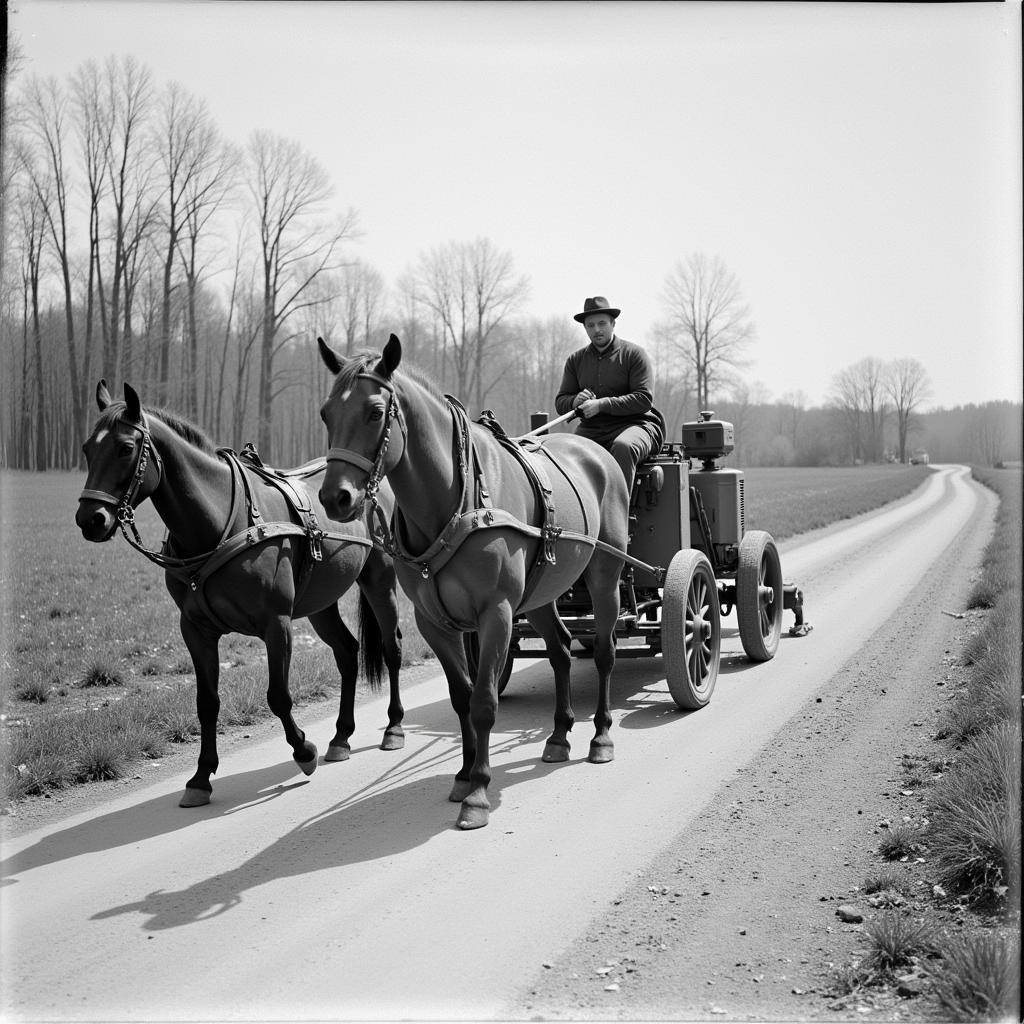Horse Drawn Road Graders played a crucial role in shaping the landscape and transportation systems of yesteryear. These ingenious contraptions, powered by the strength and reliability of horses, were instrumental in leveling roads and preparing them for travel. This article delves into the fascinating history, mechanics, and lasting impact of these essential tools of the past.
The Rise and Reign of the Horse Drawn Road Grader
Before the advent of motorized machinery, road maintenance was a laborious task. The introduction of the horse drawn road grader revolutionized this process, offering a significantly more efficient way to create and maintain roads. These graders, typically made of wood and metal, utilized a large blade that could be angled and adjusted to move earth and smooth surfaces. This allowed for the creation of more consistent and stable roadways, facilitating travel and commerce.
How Did They Work? Understanding the Mechanics
The basic design of a horse drawn road grader involved a heavy frame, a blade controlled by levers, and a hitch for attaching one or more horses. The operator would stand on a platform and manipulate the levers to adjust the blade’s angle and depth, effectively scraping and shaping the road surface.  Horse Drawn Road Grader Mechanics: A detailed diagram illustrating the key components and operating mechanisms of a typical horse-drawn road grader, including the blade, levers, frame, and horse hitch. The power of the horses, combined with the clever mechanics of the grader, made it possible to move considerable amounts of earth and create smoother, more traversable roads.
Horse Drawn Road Grader Mechanics: A detailed diagram illustrating the key components and operating mechanisms of a typical horse-drawn road grader, including the blade, levers, frame, and horse hitch. The power of the horses, combined with the clever mechanics of the grader, made it possible to move considerable amounts of earth and create smoother, more traversable roads.
The Impact of Horse Drawn Road Graders on Transportation and Society
The horse drawn road grader’s impact on society was profound. Improved roads facilitated trade and communication, connecting communities and fostering economic growth.  Horse Drawn Road Grader in Action: A historical photograph depicting a horse-drawn road grader in use, showcasing the horses, the operator, and the impact on the road surface. The ability to transport goods and people more efficiently spurred development and opened up new opportunities. These graders also played a vital role in rural areas, enabling farmers to access markets and connect with wider communities.
Horse Drawn Road Grader in Action: A historical photograph depicting a horse-drawn road grader in use, showcasing the horses, the operator, and the impact on the road surface. The ability to transport goods and people more efficiently spurred development and opened up new opportunities. These graders also played a vital role in rural areas, enabling farmers to access markets and connect with wider communities.
From Dirt Paths to Passable Roads: The Evolution of Road Construction
The development of the horse drawn road grader marked a significant step forward in road construction. Prior to its invention, roads were often little more than dirt paths, prone to rutting and impassable in wet weather. With the horse drawn grader, roads could be leveled, drained, and made more durable, significantly improving transportation.
“Horse drawn road graders were a game-changer,” says fictional historian Dr. Emily Carter, specializing in 19th-century agricultural technology. “They were a key factor in connecting rural communities and enabling the expansion of trade networks.”
The Legacy of the Horse Drawn Road Grader
While motorized graders have long since replaced their horse-drawn predecessors, the legacy of these ingenious machines remains. They represent an important chapter in the history of transportation and infrastructure development, reminding us of the ingenuity and hard work that shaped the world we live in today. Their contribution to shaping the landscape and connecting communities should not be forgotten.
“These graders may seem simple by today’s standards, but they were a marvel of engineering for their time,” adds Dr. Carter. “They demonstrate the power of human innovation to overcome challenges and improve the quality of life.”
Conclusion: Remembering the Horse Drawn Road Grader
The horse drawn road grader, a symbol of innovation and progress, played a vital role in shaping the roads and communities of the past. Its impact on transportation, trade, and rural development was significant, paving the way for the modern infrastructure we rely on today. Understanding the history and mechanics of these machines allows us to appreciate the ingenuity and hard work that went into building the world around us.
FAQ
- What was the primary purpose of a horse drawn road grader? (To level and shape roads for improved transportation.)
- How was the blade of a horse drawn road grader controlled? (By levers operated by the operator standing on a platform.)
- What impact did horse drawn road graders have on society? (Improved trade, communication, and rural development.)
- What replaced horse drawn road graders? (Motorized graders.)
- Why are horse drawn road graders important to remember? (They represent a significant step forward in road construction and transportation history.)
- What were roads like before horse-drawn road graders? (Often just dirt paths, prone to rutting and difficult to travel.)
- How did horse drawn road graders improve road conditions? (They leveled, drained, and made roads more durable.)
Need assistance? Contact us 24/7 at Phone Number: 0772127271, Email: [email protected] or visit us at QGM2+WX2, Vị Trung, Vị Thuỷ, Hậu Giang, Việt Nam.